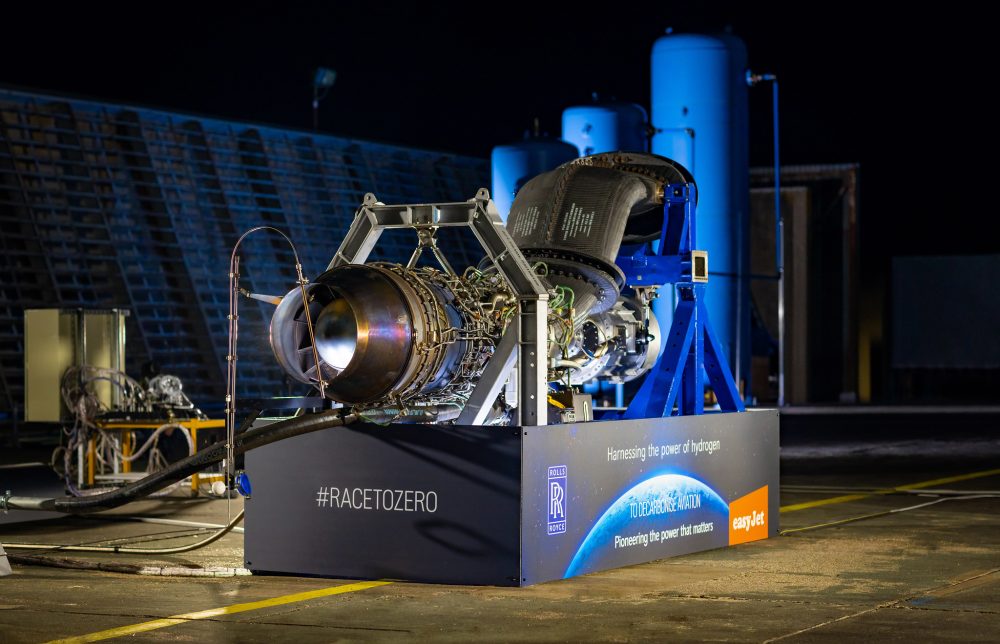Anyone following sustainability for any length of time will quickly learn that new buzzwords, technologies and concepts rapidly become ‘vogue’. Whether it’s blockchain, artificial intelligence or carbon sequestration, it’s often unclear just how revolutionary these new technologies will be. Will they make a big impact, or fall into relative obscurity?
One of the current much-discussed technologies in scientific, business and environmental circles is hydrogen – a potential fuel for the future. Hydrogen has been suggested as a new method of renewable energy storage, an energy source in its own right and now, an aviation fuel. Engineers in the UK have developed what they claim to be a functional green hydrogen jet engine.
The team, a collaboration between Rolls Royce and easyJet, recently tested a prototype at the UK Ministry of Defence’s proving grounds at Boscombe Down. Unlike traditional jet engines which often use kerosene and specially developed jet hydrocarbon fuels, the new engine uses hydrogen, with water being the only waste byproduct. Furthermore, they claim this hydrogen fuel has been synthesised with purely renewable energy, making it so-called green hydrogen.
Of course, hydrogen is not necessarily a new fuel. Afterall NASA has been using liquid hydrogen as the main fuel for their rockets since the 1950s. Hydrogen has the lowest molecular weight of any element and burns at around 3,000 degrees celsius, making it ideal for aviation where weight and power are of central importance. Taming this technology for terrestrial use, however, has issues.
The most salient issue is the difficulty, and danger, in storing hydrogen. It must be contained within pressurised containers which could potentially explode if ruptured. This is obviously not a good choice for road traffic where crashes and collisions are commonplace, or aviation where heavy landings may be required. Despite what the movies show, petroleum is relatively ‘safe’ in this regard.
Furthermore, to get any serious mileage out of hydrogen, huge amounts and requisite storage facilities are needed. That’s why it is perhaps best suited for heavy transport, ships, trains and aircraft. With this new breakthrough, the decarbonisation of part of the aviation sector may be possible.
The Rolls Royce/easyJet team claim their engine is clean primarily due to how their hydrogen is synthesised. They used a common method known as steam-methane reforming in which hot steam is used to break down the molecules of natural gas into carbon monoxide and hydrogen. For their engine, they used wind and tidal sources for the initial energy needed to power the steam-methane reforming process. Hence their claim of ‘green hydrogen’.
 Hydrogen and aviation are not entirely new bedfellows. Of course, hydrogen played a huge role in the first major forays into aviation, providing the lifting gas for airships including the famous zeppelins. However, the 1937 Hindenburg disaster soon put an end to that.
Hydrogen and aviation are not entirely new bedfellows. Of course, hydrogen played a huge role in the first major forays into aviation, providing the lifting gas for airships including the famous zeppelins. However, the 1937 Hindenburg disaster soon put an end to that.
Following World War II, further experimentation into hydrogen’s use as a fuel began. In 1957, a US B-57B jet bomber flew on hydrogen fuel – albeit for only 20 minutes. In 1988, the Soviet Union built the first experimental hydrogen airliner, the Tu-155. It flew for around 100 flights before the project was cancelled due the collapse of the Soviet Union. More recently, most hydrogen aviation projects have concerned smaller, single propeller planes and drones. Instead of using hydrogen as a gas fuel, these tend to use hydrogen fuel cells to power the engine.
How Green is Green Hydrogen?
Although hydrogen is carbon-free at its point of use, actually generating it in the first place is perhaps not always as ‘green’ as it may seem. In fact, around 96 percent of current synthesised hydrogen is so-called ‘grey hydrogen’ – which uses normal grid energy to power the steam-methane process. When produced in this way, hydrogen cannot claim to be a green alternative. For each kilo of hydrogen produced, as much as ten kilos of carbon dioxide may have also been produced. However, producing it in this way is much more affordable than smaller-batch ‘green hydrogen’.
One solution to this issue is to turn it into ‘blue hydrogen’. In this process, the carbon produced is supposedly captured and stored underground. However, this has not been demonstrated on a wide scale and it is debatable how cost effective this will be. Both grey and blue hydrogen are often also referred to as fossil hydrogen.
Even steam-methane reforming is not exactly clean. Carbon monoxide may be less damaging than carbon dioxide, but still plays a role in global warming. Also, if natural gas is further refined, carbon dioxide is also released. Although this is in relatively small amounts, some environmentalists claim it is still at unacceptable high levels.
Traditional ‘green hydrogen’ uses the process of electrolysis. Instead of using natural gas, water is separated into both oxygen and hydrogen. This process releases no carbon dioxide, but also requires relatively high amounts of power. If this power can be provided from renewable sources, then the whole process may be carbon-neutral, but this is not always the case. Green hydrogen is also the most expensive, making it the least scalable.
Despite these issues, some nations and industries are rallying around green hydrogen. The German Federal Ministry for Economic Cooperation and Development, for example, suggests green hydrogen “is absolutely essential to a successful energy transition and to achieving international climate goals”. It can be used not only to create climate-neutral fuels, but also power industry. However, the ministry also accepts that Germany lacks the renewable power capacity to generate the amount of hydrogen required.
As always, it seems one solution is to rely on already established, affordable and scalable renewable power technologies. Once these have been secured, a green hydrogen future may actually be attainable.









